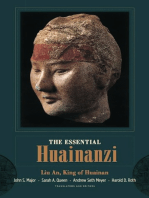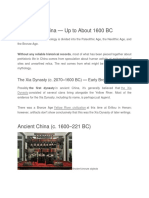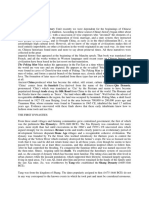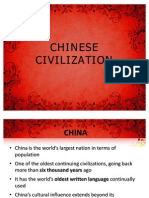613 Chinesehistory
613 Chinesehistory
Uploaded by
api-235980768Copyright:
Available Formats
613 Chinesehistory
613 Chinesehistory
Uploaded by
api-235980768Original Title
Copyright
Available Formats
Share this document
Did you find this document useful?
Is this content inappropriate?
Copyright:
Available Formats
613 Chinesehistory
613 Chinesehistory
Uploaded by
api-235980768Copyright:
Available Formats
*This is a higher order learning question.
You must answer the question to the best of your ability, but any reasonable
answer will be graded as correct.
Name:
Date:
Dynasty
From at least 1766BC to the twentieth century of the
Common Era, China was ruled by dynasties. A dynasty is
a ruling family that passes control from one generation to
the next. One Chinese dynasty lasted more than 800
years, while another lasted only fifteen years. The ancient
Chinese people often supported their rulers because of
what they called the Mandate of Heaven. The ancient
Chinese believed their ancestors in heaven had chosen
their leaders. The people would rebel against a weak
leader if they believed he had lost the Mandate of
Heaven.
The Shang Dynasty ruled China from approximately
1766BC to about 1040BC. The Shang were the first
dynasty to leave written records. The Shang rulers
expanded the borders of their kingdom to include all of
the land between Mongolia and the Pacific Ocean. The
Shang practiced human sacrifice. If a king died, many of
his subjects would join the ruler in his grave. Some
people were beheaded first but others were buried alive.
When a Shang king died, his next oldest brother replaced
him. When there were no brothers, the oldest nephew
became king.
The Chou were nomads who lived west of the Shang.
The Chou overthrew the Shang and ruled China from
1040BC to the third century before the Common Era. The
Chou gained power in part from their ability to extract
iron. They used the metal to create powerful weapons.
The Chou developed a feudal system in China. In a
feudal system, the rulers appoint nobles to control smaller
parts of an empire. The nobles divided the land into
farms for extended families. An extended family might
include many generations and would often include
cousins and second cousins. The families were loyal to
their nobles and the nobles were in turn loyal to the Chou
rulers. The Chou rulers taxed their subjects, but they used
the wealth they collected to build huge walls around their
cities to defend the citizens from nomadic warriors. The
Chou also built roads, irrigation systems, and dams.
The Chou dynasty ended slowly as nobles became
more powerful. Eventually, the nobles became more
powerful than the emperor in a period that became known
as the Age of Warring States. It was during this period
that a great teacher named Confucius tried to develop
good government.
The Ch'in state managed to unify China by 221BC.
The Ch'in rulers clearly explained and strictly enforced
laws. They standardized weights and measures and
carried out irrigation projects. The Chin also gave
peasant farmers the land they lived on. The West first
learned of China during the Ch'in dynasty. It is from
Ch'in that we get the word China.
A group known as the Legalists influenced the Ch'in
Dynasty. The Legalists tried to suppress all thoughts that
disagreed with their philosophy. People who discussed
ideas not approved by the Legalists faced execution. One
Chin ruler ordered 460 scholars to be buried alive
because the scholars disagreed with the teachings of the
Legalists.
China grew into a powerful empire during the Han
Dynasty, between 202BC and AD220. Scholars trained in
the teachings of Confucius ran the Han governments with
great skill. During the Han Dynasty, the Chinese
invented paper, Chinese writers recorded the history of
their land, and the Chinese first learned of Buddhism.
The last Chinese dynasty to rule came from
Manchuria, in northeast China. The Manchus were unable
to stop other nations from interfering with China. The
British defeated China in the Opium Wars. The outsiders
seized Hong Kong, but more importantly, the British
forced the Chinese government to allow them to sell a
dangerous drug called opium to the Chinese people. Japan
seized the island of Formosa, which later became known
as Taiwan. By the turn of the twentieth century,
foreigners had overrun China. Parts of China were ruled
by British, French, American, German, Russian, and
Japanese forces. The Chinese people believed that the
Manchus had lost the Mandate of Heaven. Many people
began to support a group known as the Nationalists, who
pledged to free China from foreign rule. In 1911, the
Nationalists drove from power a six-year-old boy, who
was the last of the Manchu rulers.
Timeline
In the space below, draw a timeline that identifies the end of the Shang Dynasty, the Chou Dynasty, the Age of Warring States, the Han
Dynasty, the end of the Manchu Dynasty and today.
*This is a higher order learning question. You must answer the question to the best of your ability, but any reasonable
answer will be graded as correct.
Name:
Date:
The Dynasties of China
Hsia (c. 2200-1766BC) -- Most historians believed the Hsia to be
a mythical dynasty, but recent archaeological findings have
verified their existence.
Shang (1766- c.1040BC) -- Excavations have confirmed
descriptions in ancient Chinese literature of a highly
developed culture. The Shang Dynasty was distinguished by
an aristocratic government, great artistry in bronze, a writing
system still in use today, an agricultural economy, and armies
of thousands whose commanders rode in chariots.
Chou (c.1040BC- 256BC) -- The semi-nomadic Chou people
from northwestern China overthrew the Shang king. The Chou
court developed a feudal society in China.
Chin (221BC-206BC) -- The group of warlords known as the
Legalists strengthened state power and control over the
people. Weights and measures, and the Chinese writing
system were unified. Chinese defenses were strengthened by
creating the Great Wall.
Han (206BC-AD220) -- The Han Dynasty is often compared to
the Roman Empire. It is considered the "Golden Age of
Chinese History." Today the Chinese word for Chinese person
means "a man of Han."
Sui (589-618) -- The Sui, Tang and Song Dynasties were quite
similar. The short-lived Sui dynasty reunified China after four
hundred years of fragmentation.
Tang (960-1279) -- Li Yuan was a Sui general who founded the
Tang Dynasty, the largest, wealthiest, and most populous in
the world at that time. The Tang based their laws on based on
Confucian thought.
Song (1279-1368) -- The Song Dynasty continued the flowering
of Chinese culture.
Yuan (1279-1368) -- Kublai Khan established the Yuan Dynasty
after his Mongol tribes defeated China. The Yuan encouraged
Europeans to travel overland to China; Marco Polo was the
most famous of the early Europeans to make the journey.
Ming (1368-1644) -- Founded by a Buddhist monk who led a
peasant army to victory over the Mongols.
Qing (1644-1911) -- Founded by conquerors from Manchuria in
1644, the Qing was the last imperial dynasty of China. When
it was overthrown in 1911, China became a republic.
Answer in complete sentences
Use the reading passage to find the correct answers.
*1. What was the Mandate of Heaven?
*2. Why do we not know if any dynasties preceded the Shang?
*3. Explain why historians do not have an exact date for the ending of the Chou dynasty.
4. Why did the Legalists order that many Chinese books be burned?
*5. Were the Manchus a strong or a weak dynasty? Support your answers with facts from the text or outside research.
6. Why did many Chinese people support the Nationalists at the beginning of the twentieth century?
You might also like
- Family Prayer For The Faithful Departed - Cubao DmlaDocument1 pageFamily Prayer For The Faithful Departed - Cubao DmladiksajonaNo ratings yet
- Civilization in China, Japan and KoreaDocument21 pagesCivilization in China, Japan and KoreamagilNo ratings yet
- Social Media Influencer Contract: Page 1 of 4Document4 pagesSocial Media Influencer Contract: Page 1 of 4Fe Rafi100% (2)
- Election OffensesDocument165 pagesElection OffensesDeb BieNo ratings yet
- Early Civilizations in China: Powerpoint By: Esther LeeDocument17 pagesEarly Civilizations in China: Powerpoint By: Esther LeeLee EstherNo ratings yet
- Ancient Chinese CivilizationDocument54 pagesAncient Chinese CivilizationMartin Elgin Balderamos Dalida100% (2)
- Ancient Chinese CivilizationDocument54 pagesAncient Chinese CivilizationPaola Fernanda MontenegroNo ratings yet
- Sunu 1Document30 pagesSunu 1Muhammed Salih AKBULUTNo ratings yet
- Asian HistoryDocument10 pagesAsian HistoryMa. Paula Fernanda Cuison SolomonNo ratings yet
- Ancient China EditedDocument78 pagesAncient China Editedchuron0% (1)
- Unit 5 PPDocument21 pagesUnit 5 PPbtcherryNo ratings yet
- 05 Política e Sociedade Chinesa (Inglês)Document42 pages05 Política e Sociedade Chinesa (Inglês)LuizFernandoChagasNo ratings yet
- 中国王朝Document6 pages中国王朝Avery Haye LimNo ratings yet
- He Dynasties and PeriodsDocument15 pagesHe Dynasties and PeriodswennyNo ratings yet
- The Xia Dynasty The Zhou Dynasty: About 1994 BCE - 1766 BCE 1122 BCE - 256 BCEDocument4 pagesThe Xia Dynasty The Zhou Dynasty: About 1994 BCE - 1766 BCE 1122 BCE - 256 BCEsprite_phx073719No ratings yet
- B - The Empires of ChinaDocument67 pagesB - The Empires of ChinaMaryMelanieRapioSumariaNo ratings yet
- WHP 3-7-5 Read - Han Dynasty - 1190LDocument7 pagesWHP 3-7-5 Read - Han Dynasty - 1190LLucas ParkNo ratings yet
- Ancient China ReportingDocument5 pagesAncient China ReportingJanine Sambajon AbreaNo ratings yet
- Qin and Han DynastyDocument4 pagesQin and Han Dynastyjerold sandovalNo ratings yet
- Ada LD 2Document143 pagesAda LD 2AryanNo ratings yet
- Assignment in Asian HistoryDocument4 pagesAssignment in Asian HistoryMarc Angelo Villalobos BantugNo ratings yet
- Chinese CivilizationDocument13 pagesChinese CivilizationRounit RaiNo ratings yet
- Ancient China: The Chinese CivilizationDocument8 pagesAncient China: The Chinese CivilizationchelseholicNo ratings yet
- Prehistoric ChinaDocument12 pagesPrehistoric ChinaHyun Sairee VillenaNo ratings yet
- Ancient Chinese CivilizationDocument68 pagesAncient Chinese CivilizationHumaira Hossain100% (1)
- Ulasan Buku About ChinaDocument8 pagesUlasan Buku About ChinaLee WongNo ratings yet
- Zhou Dynasty Location/GeographyDocument9 pagesZhou Dynasty Location/GeographyJuhaina SultanNo ratings yet
- Music of ChinaDocument43 pagesMusic of ChinaJcee EsurenaNo ratings yet
- Chinese Dynasties: Xia or Hsia c.2205 - c.1766 B.C.EDocument3 pagesChinese Dynasties: Xia or Hsia c.2205 - c.1766 B.C.EThangNo ratings yet
- 202003251320353011anil Kumar Chinese CivilizationDocument15 pages202003251320353011anil Kumar Chinese CivilizationPVP KINGNo ratings yet
- 03 CHINESE CivilizationDocument89 pages03 CHINESE Civilizationbatutascribd100% (1)
- Geography and Natural ResourcesDocument4 pagesGeography and Natural Resourcesmichelle garbinNo ratings yet
- Chapter 3 The Founding of The Bureaucratic Empire Qin-Han Dynast 256 B.C.E. - 200 B.C.EDocument7 pagesChapter 3 The Founding of The Bureaucratic Empire Qin-Han Dynast 256 B.C.E. - 200 B.C.EbobmcintoshNo ratings yet
- Chinese Dynasties For StudentsDocument4 pagesChinese Dynasties For StudentsmatreatNo ratings yet
- China: A History of China and East Asia (Ancient China, Imperial Dynasties, Communism, Capitalism, Culture, Martial Arts, Medicine, Military, People including Mao Zedong, and Confucius)From EverandChina: A History of China and East Asia (Ancient China, Imperial Dynasties, Communism, Capitalism, Culture, Martial Arts, Medicine, Military, People including Mao Zedong, and Confucius)No ratings yet
- Chinese Cultural StudiesDocument40 pagesChinese Cultural Studiesvkjha623477No ratings yet
- Concise Political History of ChinaDocument34 pagesConcise Political History of Chinagsevmar100% (1)
- China ' S Flourishing CivilizationDocument57 pagesChina ' S Flourishing CivilizationMaria Vanessa Jimenez ResullarNo ratings yet
- Brief History of China Part 2 DynastiesDocument4 pagesBrief History of China Part 2 DynastiesMelg VieNo ratings yet
- Chinese CivilizationDocument10 pagesChinese CivilizationSaimaNo ratings yet
- Oleh: Henny Rosalinda Bayu Eka PDocument25 pagesOleh: Henny Rosalinda Bayu Eka PAhmad AtimNo ratings yet
- Ancient Chinese CivilizationDocument54 pagesAncient Chinese CivilizationDaran Rungwattanasophon100% (1)
- Code of Shih-Huang-Ti (Qin Dynasty) Araling Panlipunan Projects AssignmentsDocument8 pagesCode of Shih-Huang-Ti (Qin Dynasty) Araling Panlipunan Projects AssignmentsMarinela AvenirNo ratings yet
- China Civilization Time LineDocument5 pagesChina Civilization Time LineJonathan EspelembergoNo ratings yet
- An Introduction To Chinese CultureDocument44 pagesAn Introduction To Chinese CultureirvmacNo ratings yet
- The History of ChinaDocument22 pagesThe History of ChinaJulcess Marie MercadoNo ratings yet
- 14-2 OahwdiughaDocument4 pages14-2 OahwdiughaRichard ShiauNo ratings yet
- Shang and Zhou Dynasties: The Bronze Age of China - Early Civilization | Ancient History for Kids | 5th Grade Social StudiesFrom EverandShang and Zhou Dynasties: The Bronze Age of China - Early Civilization | Ancient History for Kids | 5th Grade Social StudiesNo ratings yet
- ChinaDocument2 pagesChinaMarifer DineroNo ratings yet
- Chinese CivilizationDocument44 pagesChinese CivilizationAlex Sanchez100% (1)
- History of China: Historical SettingDocument4 pagesHistory of China: Historical Settingcamiladcoelho4907No ratings yet
- History of China - WikipediaDocument3 pagesHistory of China - WikipediaCharles Daniel RosiosNo ratings yet
- Age of Exploration: China Limits European ContactsDocument21 pagesAge of Exploration: China Limits European ContactsPol BarrigaNo ratings yet
- History projectDocument13 pagesHistory projectDr. KhanNo ratings yet
- Chinese Literature (Handout)Document14 pagesChinese Literature (Handout)Floramie Juanite100% (1)
- WHP-AP 1-2-3 Read - East Asia 1200-1450Document6 pagesWHP-AP 1-2-3 Read - East Asia 1200-1450Bao Hoang LeNo ratings yet
- Etymology: Names of ChinaDocument14 pagesEtymology: Names of ChinakimianfernanNo ratings yet
- GovernmentresearchDocument4 pagesGovernmentresearchapi-241107317No ratings yet
- Xin DynastyDocument3 pagesXin DynastyVu PhilNo ratings yet
- China Prehistory - Chinese Civilization Organized Around Yellow River inDocument5 pagesChina Prehistory - Chinese Civilization Organized Around Yellow River innadiaafzalNo ratings yet
- South Asia ProjectDocument10 pagesSouth Asia Projectapi-235980768No ratings yet
- Africa Review Board Game Questions and Answer PacketDocument8 pagesAfrica Review Board Game Questions and Answer Packetapi-235980768No ratings yet
- Afr Them LanduseDocument1 pageAfr Them Landuseapi-235980768No ratings yet
- Coding The TextDocument3 pagesCoding The Textapi-235980768No ratings yet
- Abraham The Patriarch ArticleDocument1 pageAbraham The Patriarch Articleapi-235980768No ratings yet
- The Death or Murder of King TutDocument4 pagesThe Death or Murder of King Tutapi-235980768No ratings yet
- If TestDocument2 pagesIf Testandreea conduracheNo ratings yet
- Outline of Hague ConventionDocument2 pagesOutline of Hague ConventionKyle LuNo ratings yet
- G.R. No. 211504 Federal Builders, Inc., Petitioner Vs Power Factors, Inc.Document46 pagesG.R. No. 211504 Federal Builders, Inc., Petitioner Vs Power Factors, Inc.Joedhel ApostolNo ratings yet
- 6 Days WarDocument17 pages6 Days WarwhtshyNo ratings yet
- Why IslamDocument10 pagesWhy IslamSakthi T VelNo ratings yet
- People Vs Laba GR. No. 199938Document12 pagesPeople Vs Laba GR. No. 199938Janin GallanaNo ratings yet
- Lista de VerbosDocument11 pagesLista de VerbosCesar FrancoNo ratings yet
- R and J QuotesDocument23 pagesR and J QuotesJanki VernekarNo ratings yet
- DJS 2010 Previous Year Solved Legal BitesDocument44 pagesDJS 2010 Previous Year Solved Legal BitesjatinlegalbitesNo ratings yet
- Lawyer Defense Criminal Activity Indigent Public Defenders Consent DecreesDocument2 pagesLawyer Defense Criminal Activity Indigent Public Defenders Consent DecreesColeenNo ratings yet
- Republic Act No. 11054 - Organic Law For The Bangsamoro Autonomous Region in Muslim MindanaoDocument2 pagesRepublic Act No. 11054 - Organic Law For The Bangsamoro Autonomous Region in Muslim MindanaoKheem GinesNo ratings yet
- Gender and DevelopmentDocument5 pagesGender and DevelopmentLyslyn TesoroNo ratings yet
- Santos v. Servier Philippines Inc.Document2 pagesSantos v. Servier Philippines Inc.Camille Grande100% (1)
- Chapter 204 Secretclass - UsDocument225 pagesChapter 204 Secretclass - UslecharliefrNo ratings yet
- Keeping Children Safe in Education Sep 2020 PDFDocument119 pagesKeeping Children Safe in Education Sep 2020 PDFhumejraNo ratings yet
- FUT Draft Simulator FIFA 22 Ultimate Team WeFUT 10Document1 pageFUT Draft Simulator FIFA 22 Ultimate Team WeFUT 10gines.gabaldonhermoso.2009No ratings yet
- Battle CompaniesDocument96 pagesBattle CompaniesMickael Bull Ellberg100% (4)
- Magellan Vs CADocument2 pagesMagellan Vs CANicole SantoallaNo ratings yet
- Kill Switch Discussion Quetions Penelope Douglas1174Document1 pageKill Switch Discussion Quetions Penelope Douglas1174fkathleen372No ratings yet
- HSG Anh 9 Tiền Hải 2017-2018Document7 pagesHSG Anh 9 Tiền Hải 2017-2018Thành PhạmNo ratings yet
- Ta152C User GuideDocument9 pagesTa152C User GuideEvgNo ratings yet
- Essay Question Assess The Strengths and Weaknesses of Weimar Germany Between 1919 1932Document1 pageEssay Question Assess The Strengths and Weaknesses of Weimar Germany Between 1919 1932chl23No ratings yet
- People Vs MenorDocument4 pagesPeople Vs MenorCyres Jane100% (1)
- New Light and Personal Investigation For AdventistsDocument11 pagesNew Light and Personal Investigation For AdventistsMaugahn Muff-WheelerNo ratings yet
- UR AirlinesDocument2 pagesUR Airlinesmusts jokerrNo ratings yet
- A Summer Camp in Poland. Write What He Usually Does in The Camp. Put The Verbs in Bracket in The Correct FormDocument3 pagesA Summer Camp in Poland. Write What He Usually Does in The Camp. Put The Verbs in Bracket in The Correct FormMekan SaparowNo ratings yet
- Uva-Dare (Digital Academic Repository)Document60 pagesUva-Dare (Digital Academic Repository)Dastaa Dukkallee Adoola-Abbaa MurtiiNo ratings yet































































































